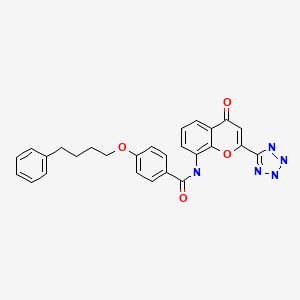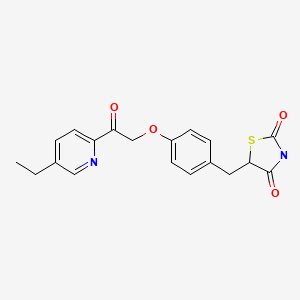
READ
Lamotrigine
CAS r: 84057-84-1
CAS Name: 6-(2,3-Dichlorophenyl)-1,2,4-triazine-3,5-diamine
Additional Names: 3,5-diamino-6-(2,3-dichlorophenyl)-1,2,4-triazine; LTG
Manufacturers’ Codes: BW-430C
Trademarks: Lamictal (GSK)
Molecular Formula: C9H7Cl2N5
Molecular Weight: 256.09
Percent Composition: C 42.21%, H 2.76%, Cl 27.69%, N 27.35%
Literature References: Prepn: M. G. Baxter et al., EP 21121 (1981 to Wellcome Foundation); D. A. Sawyer et al., US 4602017(1986).
HPLC determn in plasma: C.-L. Cheng et al., J. Chromatogr. B 817, 199 (2005).
Anticonvulsant activity: A. A. Miller et al.,Epilepsia 27, 483 (1986).
Mechanism of action studies: M. J. Leach et al., ibid. 490; X. Xie, R. M. Hagan,Neuropsychobiology 38,119 (1998).
Series of articles on clinical pharmacology, antiepileptic efficacy and safety:Epilepsia 32, Suppl. 2, S1-S21 (1991).
Clinical trial in bipolar depression: J. R. Calabrese et al., J. Clin. Psychiatry 60,79 (1999). Review of clinical experience in epilepsy: H. Choi, M. J. Morrell,Expert Opin. Pharmacother. 4, 243-251 (2003); in bipolar disorder: Z. Bhagwagar, G. M. Goodwin,Expert Opin. Pharmacother. 6, 1401-1408 (2005).
Properties: White to pale cream-colored powder. Crystals from isopropanol, mp 216-218° (uncorr). pKa 5.7. Soly at 25° (mg/ml): water 0.17; 0.1M HCl 4.1. LD50 in mice, rats (mg/kg): 250, >640 orally (Sawyer).
Melting point: mp 216-218° (uncorr)
pKa: pKa 5.7
Toxicity data: LD50 in mice, rats (mg/kg): 250, >640 orally (Sawyer)
Therap-Cat: Anticonvulsant. In treatment of bipolar depression.
Keywords: Anticonvulsant.
AND
EXAMPLES
Procedure I
To a round bottomed flask was added aminoguanidine hydrochloride (116.1 g, 1.05 mol) and dimethylformamide (900 mL). To this mixture was added methanesulfonic acid (130.4 g, 1.36 mol) followed by adding 2,3- dichlorobenzoylcyanide (150.0 g, 0.75 mol). The reaction mixture was stirred for 1 hour and then the dehydrating reagent, thionyl chloride, (45.2g, 0.38 mol) was added. The reaction mixture was stirred for another hour and then basified with KOH solution (4N). The precipitate was filtered and washed with water.
Yield: 401.3 g damp cake (KF = 39.2%).
Analytically pure sample of the intermediate is prepared as following:
20.0 g of the damp cake was suspended in 60 ml MeOH and stirred at room temperature for 3 hours. The solid was filtered and dried in vacuum at room temperature to give 5.4 g analytic pure iminoguanidine as a yellow solid.
m.p.: 179 ~ 180° C (corrected).
MS (m/z): 256.3 [M+] IR: 3491.8; 3457.1 (Amine N-H stretching); 2207.5 (CN stretching); 1681.9 (Imine C=N stretching); 1055.5 (Caryi-Cl stretching).
Η-NMR (300 MHz, DMSO-D6): 7.66 (ad, J = 7.9 Hz, 2H), 7.41 (dd, J = 7.9; 7.9 Hz, 1H), 6.70 (br s, NH2).
^C-NMR (75 MHz, DMSO-D6): 163.6, 135.3, 132.4, 130.0, 129.5, 129.0, 128.2, 114.4, 113.8.
Elemental analysis: C H N
Calculated: 42.21 2.76 27.35
Found: 42.10 2.49 27.69
Procedure II:
A round bottomed flask was charged with iminoguanidine (401.3 g from procedure I), isopropanol (1000.0 ml) and KOH (85%, 12.0 g, 0.18 mol). The reaction mixture was refluxed for 3 hours. Isopropanol was distilled and water (800 ml) was added. The reaction mixture was stirred for 3 hours, the solid was filtered and washed with water. The damp cake is dried under vacuum to yield 168.5 grams of lamotrigine monohydrate as crystalline solid (82% based on 2,3-dichlorobenzoyl cyanide).
Procedure III (without isolation of intermediate of formula IV):
To a round bottomed flask was added aminoguanidine hydrochloride (116.1 g, 1.05 mol) and dimethylformamide (900 ml). To this mixture was added methanesulfonic acid (130.4 g, 1.36 mol) followed by 2,3-dichlorobenzoyl cyanide (150.0 g, 0.75 mol). The reaction mixture was stirred for 1 hour and then dehydrating reagent thionyl chloride (45.2g, 0.38 mol) was added slowly. The reaction mixture was stirred for another hour and then basified with KOH solution (4 N). The Reaction mixture was heated under reflux (100 ~ 105° C) for 3 ~ 4 hours and cooled slowly to room temperature. The solid was filtered and washed with water. After drying, 160.7g of lamotrigine monohydrate as a crystalline solid (78% based on 2,3-dichlorobenzoyl cyanide) was obtained.
See also FIG. 1, 2, 3.
Karl Fischer (water content): 5.92 – 6.03%
DSC: 106.86, 216.65° C (onset).
MS (m/z): 256.3 [M+]
IR: 3496.9; 3450.3; 3338.5; 3211.0; 1658.7; 1524.0; 1328.8; 1027.1.
iH-NMR (300 MHz, DMSO-D6): 7.66 (ad, J = 7.9 Hz, 2H), 7.41 (dd, J = 7.9; 7.9 Hz, 1H), 6.70 (br s, NH2).
13C-NMR (75 MHz, DMSO-D6): 163.6, 135.3, 132.4, 130.0, 129.5, 129.0, 128.2, 114.4, 113.8.
Procedure IV (preparation of anhydrous lamotrigine from lamotrigine monohydrate):
150 g lamotrigine monohydrate (from procedure II or III) was recrystallized in 900 mL isopropanol giving 132 g (94%) of anhydrous lamotrigine as a crystalline solid.
See also FIG. 4, 5, 6.
m.p.: 216 – 217° C (corrected).
MS (m/z): 256.3 [M+]
Η-NMR (300 MHz, DMSO-D6): 7.69 (dd, J = 1.7; 7.9 Hz, 1H), 7.43 (dd, J = 7.9; 7.6 Hz, 1H), 7.35 (dd, J = 1.7; 7.6 Hz, 1H), 6.70 (br s, NH2), 6.44 (br s, NH2).
13C-NMR (75 MHz, DMSO-D6): 162.1, 154.1, 138.3, 136.8, 132.0, 131.6, 130.6, 128.5. Elemental analysis: C H N
Calculated: 42.21 2.76 27.35
Found: 42.10 2.58 27.46
READ

